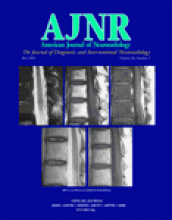Abstract
BACKGROUND AND PURPOSE: Because venous hypertension determines the clinical severity of dural arteriovenous fistulas (DAVFs), evaluation of intracranial venous pressure is important in making decisions concerning treatment. We determined whether intracranial venous hypertension could be quantified by using an acetazolamide test in a manner that indicates whether treatment of the DAVF is necessary.
METHODS: We enrolled 21 untreated patients: 11 with a sigmoid and/or transverse DAVF, six with a cavernous DAVF, two with an anterior cranial fossa DAVF, and two with a superior sagittal sinus DAVF. Cerebral hemodynamics were studied with stable-xenon CT. Patients were angiographically classified into three groups, and regional cerebral blood flow (rCBF) after acetazolamide challenge was compared between angiographic groups, between patients with and those without symptoms attributable to intracranial venous hypertension, and between preembolization and postembolization examinations.
RESULTS: A high angiographic grade was associated with decreased resting rCBF and a blunted response to acetazolamide. Response to acetazolamide was more sensitive to venous hypertension, as angiographically assessed, than decreased resting rCBF. Resting rCBF and the increase in rCBF associated with acetazolamide were significantly lower in the symptomatic group than in the asymptomatic group. Treatment of the DAVF significantly enhanced the increased rCBF due to the acetazolamide challenge.
CONCLUSION: Cerebral venous hypertension in DAVF reduced the response to acetazolamide, as shown on stable-Xe CT. Therefore, a patient with DAVF and a reduced rCBF response to acetazolamide requires treatment irrespective of his or her symptoms.
- Copyright © American Society of Neuroradiology












